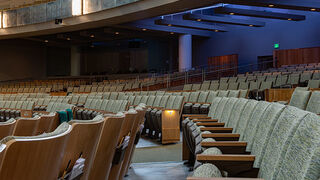Visibility Factors: How To Give Your Audience A Great Visual Experience
By Jenna Brown
December 10, 2020

What your guests are able to see when they sit down to enjoy a show is among the most important concerns when designing a space. Good sight lines are a must. Guest seating also needs to be safe and easy to get in and out without disturbing the performance. Keeping these basic guest considerations in mind before starting can lead to a better designed theater for a more enjoyable viewer experience.
Understand The Purpose Of The Space
The way the space will be used is one of the top factors that dictate how seats should be placed. You will want to remember what people will be viewing when you are deciding how to provide the best sight lines.
For instance, if the space will be used for dance performances, it is important that all guests are able to see the floor of the stage and the dancers' feet. If these sight lines are obstructed and patrons can't see your performers' footwork, they can miss out on some of the most important action. This can mean a poor viewing experience.
In a movie theater, by contrast, viewers will be staring at a screen off the floor. Each seat must afford a clear and strain-free view. Different seats in the theater will need different positioning to accommodate that. Some people might be in the front of the room looking up. Here, you'd want staggered seating to increase ease of viewing. Angled chairs also allow people to look up without having to strain. In the back of the theater, seating should be more upright. By ensuring that everyone can view the screen without craning their necks, you can be sure that your audience has a comfortable viewing experience.
How To Make Sure Other Patrons Don't Block The View
Choosing the right chair stagger method for your space is key to ensuring that, even with a full house, everyone has a great view. The type of chair stagger you choose will depend on a number of factors.
When there isn't much of a rise between rows, patrons will have a harder time getting a view of the action. Staggering seats using methods like a sawtooth stagger can make it easier to get a clear line of sight. A sawtooth stagger simply involves shifting alternate rows by half a chair total or one quarter chair each way.
An odd-even parallel method alternates the size and quantities of chairs in any given row. For instance, you can improve sight lines by alternating between rows that contain 11 twenty-inch chairs and 10 twenty-two inch chairs. This is not too common but it does work to achieve the seat goals. However, row size is key to the effectiveness. This often cannot work well with rows that have nine or fewer chairs. Please note that in order to accomplish this, aisle lines will not be constant.
When staggering seats, you can increase by one chair for each row as you go away from the stage, which completely depends on the space size. This allows you to conform to the dimensions of a space and keep the lines looking clean.
Some elements of theater design allow for better sight lines without having to stagger the rows. More height between rows means less of a need to stagger. If one patron can see over the person in front of them, you can have them aligned more closely. Reduced staggering unifies the look of the space more, offering clean lines. This is particularly helpful if you are dealing with different fabrics. The result is a theater space that looks clean and unified when looking up at the seating, without having to sacrifice sight lines. There are a number of options available to mount chairs to give you the height and placement that you need.
The Right Aisle Lighting For Safety & Comfort
Designers need to maintain a careful balance when it comes to aisle lighting. On the one hand, aisle lighting needs to be bright enough that it can allow patrons to navigate a space safely if they need to leave during a performance. On the other, lighting that is too bright can make it harder for guests to see what's going on on the screen or stage.
We offer a number of LED aisle light options that can discreetly yet safely light your space during performances. LED lights also have the advantage of producing little to no heat and consuming power sparingly. Which choice works best for your venue will depend on factors like step height and aisle width. Often, minimum heights and widths are dictated by local code requirements and ADA rules.
In some spaces, our Focal or Beacon lights, which are mounted on panels and come pre-wired, can cast light down at the walking surface, which keeps light out of patrons' eyes while they watch the show. In other cases, chairs will have space for an option like our Concealed LED Aisle Light. These can be mounted under the armblock or within a No. 10 aisle panel. Each of these options are compatible with most wood and laminate surfaces. However, most are not available on seats with ADA flip-up arms or on seats with writing tables. Get in touch to learn about potential limitations and which aisle lighting will work best for you.
Taking all of these concerns together, and pairing them with design that makes a pleasing space, can make for a better experience every time your guests come to see a show. Get in touch today to discuss your performance space's needs and the best ways to accommodate them.